Not Quite Computing, Almost Art
Having been studiously ignored for decades, computer art's early history is finally receiving the attention it deserves. Catherine Mason's book on its British variant uncovers how mainframe computing and arts education came gloriously, if briefly, together. Review by Simon Ford
‘Not Quite Computing, Almost Art’ was John Lansdown's title in 1974 for his regular column in the British Computer Society's The Computer Bulletin. He later changed it to the more assertive and less apologetic ‘Not Only Computing - Also Art’. This uncertainty as to the status of computer art permeated its early history and informed its practitioners' many struggles to gain respect from both their scientific and artistic peers. It is the story of these pioneers and their struggles that Catherine Mason tells in her new book, A Computer in the Art Room: The Origins of British Computer Arts 1950-1980.
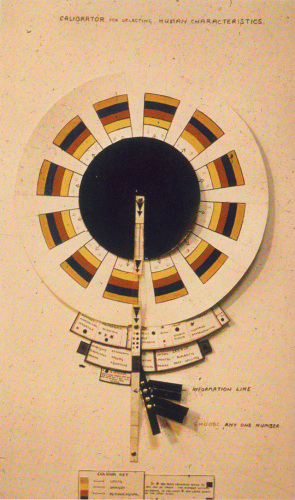
Image: Student work, Calibrator used at Ealing College of Art. c. 1963
Mason was a member of CACHe (Computer Arts, Contexts, Histories, etc), a research group based at Birkbeck, University of London, from 2002 to 2005. She also curated Bits in Motion, a screening of early British computer animation, at London's National Film Theatre in 2006. A Computer in the Art Room draws on her research for these projects and includes the fruit of over 60 personal interviews with artists and technicians directly involved with this pioneering period of computer arts. Her book opens with a brief account of British post-war history with particular reference to technological progress, plus a summary of the major developments in art education up to the immediate post-war period. The latter is particularly important for Mason because a major theme of her book is the influence of educational theories and their institutional manifestations on the formation of computer arts as a discipline. Put simply, this educational context enabled the bringing together of expertise (both artistic and scientific), equipment (which at this time was both prohibitively expensive and bulky) and the belief that something worthwhile might result from their fusion.
Mason's history of art education highlights how it separated into two streams during the eighteenth century. On the one hand there was instruction in fine art ‘for its own sake’ and on the other vocational training in the ‘useful’ arts of craft and design. In the 20th century these divisions were maintained through differences in the teaching styles and curriculum of the older universities and the new polytechnics. Computer arts, according to Mason, thrived in the latter because of an openness to experiment with media outside of the traditional art forms of painting and sculpture. Cross-disciplinary opportunities for collaboration were also encouraged, helping bridge the gap between science and the humanities (what CP Snow termed in 1956 the ‘two cultures’). Therefore it was no coincidence that computer art developed during a time when formerly independent art schools were being forced to merge with larger polytechnics. Equally important was the scrapping of centralised examinations and their replacement by the Diploma in Art and Design (Dip.A.D.). The increasing academic credibility of art and design courses was further consolidated by the new requirement of two A-levels for admission and the introduction in 1974 of the BA (Hons) degree. Although keen to recognise the positive outcomes of these developments, Mason is less critical of their many subsequent drawbacks. The new polytechnics, or new universities as they became in the 1980s and 1990s, increasingly forced art and design education to conform to models better suited to other disciplines. And as more students entered education, studio space for the arts shrank disastrously. This led computer arts down a road far removed from the experimental educational practices lauded by Mason, such as Basic Design and Roy Ascott's ‘Groundcourse’.
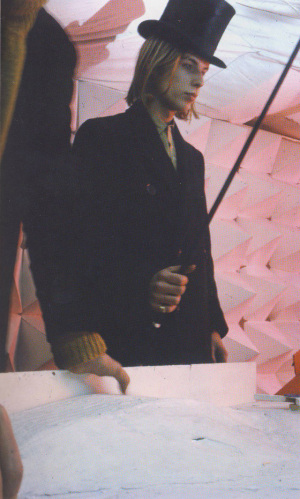
Image: Brian Eno at Ipswich Civic College, c. 1964-66
Ascott initiated the ‘Groundcourse’ in 1961 at Ealing College of Art. It was basically a two-year foundation course that drew on and extended many of the ideas associated with Basic Design. Both posited a ‘back to the basics’ analysis of form and materials, a rejection of academic formulas, the embrace of modern and abstract art and an emphasis on processes rather than results. The new magic ingredient for Ascott was cybernetics. ‘The Groundcourse’, he wrote at the time:
places the student at the centre of a system of visual education designed to develop in him awareness of his personal responsibility towards idea, persons and the physical environment such that he may contribute to a social context within which his subsequent professional activity may become wholly creative and purposive.
The course followed no official timetable and drew much of its direction from visiting inspirational lecturers such as the artist Gustav Metzger and the cybernetician Gordon Pask. Unfortunately the course not only questioned the preconceptions of the students, it also mystified the admission tutors of Dip.A.D. courses who, when presented with portfolios full of diagrams and reports, found them impossible to evaluate. Lasting just three years Ascott took the ‘Groundcourse’ to Ipswich where tutors such as Stroud Cornock and Stephen Willats carried out further work with cybernetics and art and where students such as Brian Eno thrived.
Alongside Ealing and Ipswich, Mason's account also focuses on courses at Coventry's Lanchester Polytechnic, Middlesex Polytechnic, and the City of Leicester Polytechnic. Outside of London, with its commercial art galleries and historical institutions, interesting experiments could take place away from the pressures of academic results and commercial profitability. It was here that new and far-reaching initiatives could be started. In this respect Mason rightly highlights the historical significance of Leicester Polytechnic which, in collaboration with the Slade School of Fine Art, was the first institution to register and award a Ph.D. degree to a fine art student. Equally significant was that these students were producing computer art, with Stephen Scrivener in 1974, the first to register, and the kinetic sculptor Andrew Stonyer, the first to be awarded a doctorate in 1978. As practice-led Ph.D.s have now become one of the few growth areas in art and design research departments, these early projects illuminate many issues surrounding the complex relationship between art and research. At this point Mason might have usefully compared the education given to artists to that given to computer scientists. Also some comparison with other countries and their education systems might have been instructive. For example, what was the American route into computer arts, a situation where corporate sponsorship by the likes of Bell, Boeing and IBM was more forthcoming and a greater presence on campus?
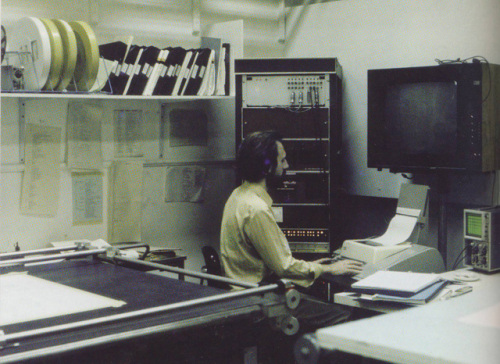
Image: Dominic Boreham in the Slade computer studio previewing a drawing on the green-screen, 1977
Many of these developments in art education would not have happened without the popularisation of cybernetics from the 1950s onwards. Cybernetics opened up new ways of thinking about communication. Artists were particularly attracted to the idea of feedback and its ability to subvert the idea of the fixed and autonomous artwork. Cybernetics, along with information theory, game theory and science fiction, informed discussion at the influential Independent Group based at the Institute of Contemporary Art in London and can be seen as key elements in a series of important exhibitions that explored relationships between art and technology. It was these exhibitions - Growth and Form (1951), Man, Machine and Motion (1955), and This is Tomorrow (1956) - that laid the groundwork for the future development of computer art.
Whilst acknowledging that there is much background to be established, it is still frustrating that the first encounter with an artist creating computer art should come quite late into the book. This artist, Edward Ihnatowicz (1926-88), remains a relatively unknown figure outside of the computer arts world. After turning quite late in life to art, his career quickly grew from making small kinetic sculptures in his studio to managing a major research and construction project at University College London for the Philips Corporation. The result was the Senster, and Philips installed it at their visitor centre in Eindhoven, the Netherlands, in 1970. By all accounts it was recognised at the time as the first major work of computer art. That it was never properly operated and was quietly decommissioned after just a few years on display also reveals that being a major work of computer art did not actually carry much lasting significance at the time.
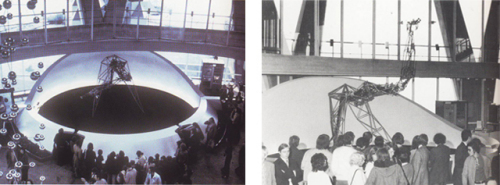
Image: The Senster installed at the Evoluon, Eindhoven, c. 1971 – two views
One of Ihnatowicz's earliest kinetic artworks was exhibited at the ICA's Cybernetic Serendipity exhibition in 1968. Not surprisingly this seminal exhibition features strongly in Mason's book and she details the many issues raised by it. Of particular concern to some artists was the number of technicians, engineers and scientists taking on the role of artists. More critical than these issues around the division of professional labour was Gustav Metzger's belief that overall the embrace of technology shown by the exhibitors was too uncritical and that corporate sponsorship of the exhibition compromised any potential for meaningful critique.
Despite these criticisms Cybernetic Serendipity acted as a catalyst for at least one significant development. The Computer Arts Society (CAS) was founded as an artist-run organisation dedicated to interdisciplinary experimentation. Its first exhibition, aptly named Event One in March 1969, employed computers as tools to enhance the production of work in many fields, including architecture, theatre, music, poetry, and dance. Over the next few years CAS became the focus of computer arts activity in Britain, helping organise exhibitions and displays, promote collaborations and report through PAGE, its regular news bulletin, on recent events and initiatives. This was the period when computer arts was most directly plugged into the avant-garde currents of the day. It lasted up to the point when computers became a part of everyday life and when polytechnic budgets could not keep up with the cost of the latest supercomputers. With clear commercial benefits the private sector emerged to take over much of their research and development functions. The killer application that ensured the further marginalisation of computer arts was the success of computer graphics and animation.
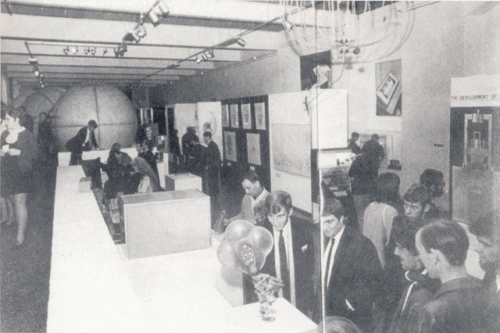 Image: Installation view of Cybernetic Serendipity at the ICA showing SAM in centre foreground, London, 1968
Image: Installation view of Cybernetic Serendipity at the ICA showing SAM in centre foreground, London, 1968
Mason's book serves well as a key resource for anybody interested in computers and art in Britain during the post-war period. It comprehensively documents key events and artists and is richly illustrated by many previously unpublished photographs and illustrations. However, its structure is sometimes confusing, resulting in too much fluctuation between thematic, chronological and biographical chapters which inevitably results in too much unnecessary repetition. Although much of her research was based on interviews, there is surprisingly little direct quotation and perhaps more could have been made of the artist's own descriptions and interpretations of what they were trying to achieve at the time. This becomes particularly important when you consider the poor survival rate of much computer art and Mason's subsequent difficulty in providing extensive analysis of individual works. It could also be argued that computer art remains too tied to a technologically unstable medium to be fully embraced as art and that this will continue until computers become a redundant technology, until they become practically useless. As Gustav Metzger, Gordon Hyde and Jonathan Benthall stated in their ‘Zagreb Manifesto’ of 1969: ‘A great deal of computer art embodies the limitation of existing techniques.’
Simon Ford <hippriestauthor AT hotmail.com> is a freelance writer on art, craft and design.
Info
Catherine Mason, A Computer in the Art Room: the Origins of British Computer Arts 1950-80, Hindringham: JJG Publishing, 2008
Mute Books Orders
For Mute Books distribution contact Anagram Books
contact@anagrambooks.com
For online purchases visit anagrambooks.com






